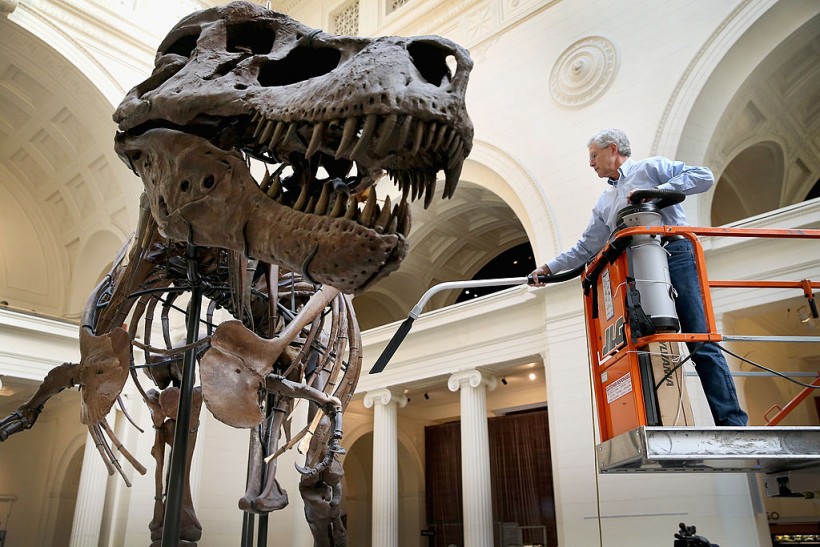For quite some time now, scientists have been stumped as to why the golf ball-sized holes in the skull of one of the world's best-known dinosaur fossils.
Sue, the largest and best preserved Tyrannosaurus Rex ever unearthed, undoubtedly was a frightful beast when this predator prowled what is currently called South Dakota approximately 67 million years ago "at the twilight of the age of dinosaurs, The Jerusalem Post reported.
What caused the holes in this prehistoric T-Rex's jawbone? - study https://t.co/wkDRy2eHJt
— Terra Fossil Dinosaurs - Merch & Apparel 🦕🦖 👕 (@terrafossil) October 1, 2022
However, even this gigantic dinosaur, whose fossils are exhibited at the Field Museum in Chicago, was not invulnerable.
The main example of this is the series of circular holes in the jawbone of Sue that continue to baffle scientists.
ALSO READ: Skull of Prehistoric Giant Sloth Unearthed by South American Scientists

Geologist Bill Simpson cleans Sue, a 67-million-year-old Tyrannosaurus Rex on display at the Field Museum on November 12, 2013, in Chicago, Illinois.
Investigating Infection that Causes the Hole
A new study published in Cretaceous Research, seeking an explanation for such holes, has managed to rule out a major hypothesis, although the answer stays elusive.
The study authors said a close examination of the eight holes, some of which were the diameter of a golf ball, on the back of the lower jawbone of Sue, or mandible, identified that they were not caused by a type of microbial infection as proposed by some experts.
According to a medical doctor and research associate, Bruce Rothschild, the holes were found to be different from bone damage resulting from such an infection from the Carnegie Museum of Natural History in Pittsburgh. He's also the lead author of this recently published study.
Measuring 40.5 feet in length represents one of the best-known dinosaur fossils in the world. In addition, tyrannosaurus was one of the largest land predators, inhabiting western North America at the end of the Cretaceous Period.
Protozoans Bacteria Examined
Field Museum Paleontologist Jingmai O'Connor, the study's co-author, noted that roughly 15 percent of all known T. rex specimens have holes akin to Sue's.
The study investigators explored if the holes resulted from an infection involving bacteria known as protozoans.
One common protozoan infection known to occur in birds, which evolved from feathered dinosaurs and humans, is called trichomoniasis due to the parasitic protozoan. Trichomoniasis in humans, though not birds, is a sexually transmitted disease.
O'Connor noted that one falcon diagnosed with this STD had exhibited damage in its jaw, although it differed from the holes of Sue.
Sue's Holes, Still a Mystery
As specified in a similar Reuters report, Rothschild proposed the probability of claw damage while mating, or as he put it, "mounting from back or top with claws, striking the posterior mandible."
Sue owns a feminine name, honoring the woman who found the fossils in 1990, although the gender of the dinosaur remains unknown.
On the investigation, O'Connor said he honestly doesn't know what formed the holes. He added he does not think "they are bite marks or claw marks."
The paleontologist also explained that it commonly affected T. rex individuals, causing big holes to open up in the jawbone but only in the back of the jawbone, although it did not kill Sue since the holes began to heal, at least in this T. rex, and it seems strange.
A report about the hole in Sue the T.rex's jawbone is shown on Fox 32 Chicago's YouTube video below:
RELATED ARTICLE: Fossilized Bony Lungs of Ancient Fish Reveals It Is as Big as Great White Shark
Check out more news and information on Paleontology in Science Times.














